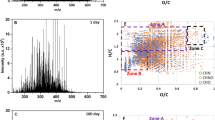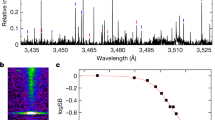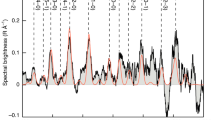Abstract
The presence of solid carbonaceous matter in cometary dust was established by the detection of elements such as carbon, hydrogen, oxygen and nitrogen in particles from comet 1P/Halley1,2. Such matter is generally thought to have originated in the interstellar medium3, but it might have formed in the solar nebula—the cloud of gas and dust that was left over after the Sun formed4. This solid carbonaceous material cannot be observed from Earth, so it has eluded unambiguous characterization5. Many gaseous organic molecules, however, have been observed6,7,8,9; they come mostly from the sublimation of ices at the surface or in the subsurface of cometary nuclei8. These ices could have been formed from material inherited from the interstellar medium that suffered little processing in the solar nebula10. Here we report the in situ detection of solid organic matter in the dust particles emitted by comet 67P/Churyumov–Gerasimenko; the carbon in this organic material is bound in very large macromolecular compounds, analogous to the insoluble organic matter found in the carbonaceous chondrite meteorites11,12. The organic matter in meteorites might have formed in the interstellar medium and/or the solar nebula, but was almost certainly modified in the meteorites’ parent bodies11. We conclude that the observed cometary carbonaceous solid matter could have the same origin as the meteoritic insoluble organic matter, but suffered less modification before and/or after being incorporated into the comet.
This is a preview of subscription content, access via your institution
Access options
Subscribe to this journal
Receive 51 print issues and online access
$199.00 per year
only $3.90 per issue
Buy this article
- Purchase on Springer Link
- Instant access to full article PDF
Prices may be subject to local taxes which are calculated during checkout

Similar content being viewed by others
Change history
05 October 2016
The affiliation for author Y.L. was corrected.
References
Kissel, J. et al. Composition of comet Halley dust particles from Giotto observations. Nature 321, 336–337 (1986)
Kissel, J. et al. Composition of comet Halley dust particles from Vega observations. Nature 321, 280–282 (1986)
Greenberg, J. M. Making a comet nucleus. Astron. Astrophys. 330, 375–380 (1998)
Nuth, J. A., III, Johnson, N. M. & Manning, S. A self-perpetuating catalyst for the production of complex organic molecules in protostellar nebulae. Astrophys. J. 673, L225–L228 (2008)
Fomenkova, M. N., Chang, S. & Mukhin, L. M. Carbonaceous components in the comet Halley dust. Geochim. Cosmochim. Acta 58, 4503–4512 (1994)
Biver, N. et al. Ethyl alcohol and sugar in comet C/2014 Q2 (Lovejoy). Sci. Adv. 1, e1500863 (2015)
Le Roy, L. et al. Inventory of the volatiles on comet 67P/Churyumov-Gerasimenko from Rosetta/ROSINA. Astron. Astrophys. 583, A1 (2015)
Mumma, M. J. & Charnley, S. B. The chemical composition of comets—emerging taxonomies and natal heritage. Annu. Rev. Astron. Astrophys. 49, 471–524 (2011)
Altwegg, K. et al. Prebiotic chemicals—amino acid and phosphorus—in the coma of comet 67P/Churyumov-Gerasimenko. Sci. Adv. 2, e1600285 (2016)
Bockelée-Morvan, D. et al. New molecules found in comet C/1995 O1 (Hale-Bopp). Investigating the link between cometary and interstellar material. Astron. Astrophys. 353, 1101–1114 (2000)
Alexander, C. M. O. D., Fogel, M., Yabuta, H. & Cody, G. D. The origin and evolution of chondrites recorded in the elemental and isotopic compositions of their macromolecular organic matter. Geochim. Cosmochim. Acta 71, 4380–4403 (2007)
Quirico, E. et al. Origin of insoluble organic matter in type 1 and 2 chondrites: new clues, new questions. Geochim. Cosmochim. Acta 136, 80–99 (2014)
Kissel, J. et al. COSIMA, a high resolution time of flight spectrometer for secondary ion mass spectroscopy of cometary dust particles. Space Sci. Rev. 128, 823–867 (2007)
Schulz, R. et al. Comet 67P/Churyumov–Gerasimenko sheds dust coat accumulated over the past four years. Nature 518, 216–218 (2015)
Langevin, Y. et al. Typology of dust particles collected by the COSIMA mass spectrometer in the inner coma of 67P/Churyumov Gerasimenko. Icarus 271, 76–97 (2016)
Hilchenbach, M. et al. Comet 67P/Churyumov–Gerasimenko: close-up on dust particle fragments. Astrophys. J. 816, L32 (2016)
Le Roy, L. et al. COSIMA calibration for the detection and characterisation of the cometary solid organic matter. Planet. Space Sci. 105, 1–25 (2015)
Quirico, E. et al. Refractory and semi-volatile organics at the surface of comet 67P/Churyumov-Gerasimenko: insights from the VIRTIS/Rosetta imaging spectrometer. Icarus 272, 32–47 (2016)
Danger, G. et al. Characterization of laboratory analogs of interstellar/cometary organic residues using very high resolution mass spectrometry. Geochim. Cosmochim. Acta 118, 184–201 (2013)
Schmitt-Kopplin, P. et al. High molecular diversity of extraterrestrial organic matter in Murchison meteorite revealed 40 years after its fall. Proc. Natl Acad. Sci. USA 107, 2763–2768 (2010)
Sephton, M. A. Organic compounds in carbonaceous meteorites. Nat. Prod. Rep. 19, 292–311 (2002)
Cottin, H. & Fray, N. Distributed sources in comets. Space Sci. Rev. 138, 179–197 (2008)
Wright, I. P. et al. CHO-bearing organic compounds at the surface of 67P/Churyumov-Gerasimenko revealed by Ptolemy. Science 349, aab0673 (2015)
Goesmann, F. et al. Organic compounds on comet 67P/Churyumov-Gerasimenko revealed by COSAC mass spectrometry. Science 349, aab0689 (2015)
Kissel, J. & Krueger, F. R. The organic component in dust from comet Halley as measured by the PUMA mass spectrometer on board Vega 1. Nature 326, 755–760 (1987)
Flynn, G. J., Keller, L. P., Feser, M., Wirick, S. & Jacobsen, C. The origin of organic matter in the solar system: evidence from the interplanetary dust particles. Geochim. Cosmochim. Acta 67, 4791–4806 (2003)
Dartois, E. et al. Ultracarbonaceous Antarctic micrometeorites, probing the Solar System beyond the nitrogen snow-line. Icarus 224, 243–252 (2013)
Brownlee, D. The Stardust mission: analyzing samples from the edge of the Solar System. Annu. Rev. Earth Planet. Sci. 42, 179–205 (2014)
Alexander, C. M. O. D., Cody, G. D., Fogel, M., Yabuta, H. & Sanford, S. in Organic Matter in Space Vol. 251 (ed. Kwok, S. ) 293–298 (2008)
Ciesla, F. J. & Sandford, S. A. Organic synthesis via irradiation and warming of ice grains in the Solar nebula. Science 336, 452–454 (2012)
Brownlee, D. et al. Comet 81P/Wild 2 under a microscope. Science 314, 1711–1716 (2006)
Kissel, J., Krueger, F. R., Silén, J. & Clark, B. C. The cometary and interstellar dust analyzer at comet 81P/Wild 2. Science 304, 1774–1776 (2004)
Hornung, K. et al. Collecting cometary dust particles on metal blacks with the COSIMA instrument onboard ROSETTA. Planet. Space Sci. 103, 309–317 (2014)
Kerridge, J. F., Chang, S. & Shipp, R. Isotopic characterisation of kerogen-like material in the Murchison carbonaceous chondrite. Geochim. Cosmochim. Acta 51, 2527–2540 (1987)
Acknowledgements
COSIMA was built by a consortium led by the Max-Planck-Institut für Extraterrestrische Physik, Garching, Germany, in collaboration with: the Laboratoire de Physique et Chimie de l’Environnement et de l’Espace, Orléans, France; the Institut d’Astrophysique Spatiale, CNRS/Université Paris Sud, Orsay, France; the Finnish Meteorological Institute, Helsinki, Finland; the Universität Wuppertal, Wuppertal, Germany; von Hoerner und Sulger GmbH, Schwetzingen, Germany; the Universität der Bundeswehr, Neubiberg, Germany; the Institut für Physik, Forschungszentrum Seibersdorf, Seibersdorf, Austria; and the Institut für Weltraumforschung, Österreichische Akademie der Wissenschaften, Graz, Austria; and is led by the Max-Planck-Institut für Sonnensystemforschung, Göttingen, Germany. We acknowledge the support of the national funding agencies of Germany (Deutsches Zentrum für Luft- und Raumfahrt (DLR), grant 50 QP 1302), France (Centre National d’Étude Spatiales (CNES)), Austria, Finland and the European Space Agency (ESA) Technical Directorate. A.B. acknowledges support from the CNES and the Labex Exploration Spatiale des Environnements Planétaires (ESEP; no. 2011-LABX-030), and funding from the Idex Paris Sciences et Lettres (PSL; no. ANR-10-IDEX-0001-02). S.S. acknowledges support from the Swedish National Space Board grant (contracts 121/11 and 198/15). H.L., B.Z. and K.L. acknowledge Academy of Finland grant 277375. We thank the Rosetta Science Ground Segment at the European Space Astronomy Centre, the Rosetta Mission Operations Centre at the European Space Operations Centre, and the Rosetta Project at the European Space Research and Technology Centre for their work, which enabled the scientific return of the Rosetta mission.
Author information
Authors and Affiliations
Contributions
N.F. and A.B. carried out the first identification of carbon in the particles presented here, and contributed to interpreting the results. N.F. provided the figures. H.C. contributed to the interpretation, and wrote the manuscript with the assistance of A.B. and N.F. J.K. and M.H. are the two successive managers of the project. K.A., L.C., A.G., E.G., G.H., H.He., H.Hö., K.H., E.K.J., J.K., A.K., Y.L., F.R., J.R., R.S., J.S., W.S., T.S., L.T., R.T., K.T., K.V. and K.-P.W. contributed to instrument development. H.F., M.H., A.K., Y.L., J.P., J.R., O.S. and L.T. contributed to instrument operations and data distribution. D.B., A.B., C.B., H.C., C.E., N.F., M.H., K.H., H.K., J.K., H.L., K.L. Y.L., L.L.R., S.M., P.M., F.-R.O.-D., J.P., J.R., J.S., S.S., O.S., L.T. and B.Z. contributed to instrument calibration and data analysis. Y.L. provided grain pictures. All authors discussed the results and commented on the manuscript.
Corresponding author
Ethics declarations
Competing interests
The authors declare no competing financial interests.
Additional information
Reviewer Information
Nature thanks C. Alexander and the other anonymous reviewer(s) for their contribution to the peer review of this work.
After the proprietary period of six months, the data will be available in the ESA Planetary Science Archive (see Methods).
Extended data figures and tables
Extended Data Figure 1 Optical images of the particles Kenneth and Juliette.
These sub-pixel sampled images have an equivalent resolution of 10 μm (ref. 15). Each is the sum of two images, obtained with two grazing incidence illuminations from the left and the right. A square-root scaling has been used to bring out weakly illuminated regions. These images were acquired on 4 June 2015 (Kenneth) and 25 November 2015 (Juliette).
Extended Data Figure 2 TOF-SIMS spectra acquired on five different cometary particles.
The spectra in red were acquired on the cometary particles named Fadil, Jean-Pierre, Jessica, Kerttu and Stefane. The spectra in black were acquired on the respective gold targets, near the cometary particles. The latter spectra are normalized to the intensity of characteristic fragments of PDMS observed on the particles (see Methods). a, Positive-ion spectra. b, c, Enlargements from a. d, Negative-ion spectra. More details about the particles are in Extended Data Table 1.
Extended Data Figure 3 Signatures of carbon in positive-ion spectra.
The spectra in red were measured on the two cometary particles studied here, Kenneth and Juliette, and on an IOM sample extracted from the Orgueil and Murchison chondrites. The spectra in black were measured on the targets, near the cometary particles or the IOM samples.
Extended Data Figure 4 Spatial distribution of the carbon secondary ions of the particles Kenneth and Juliette.
The colour scale shows the values of the carbon/PDMS intensity ratios, on and off the particles, in negative and positive modes. The white ellipses indicate the size of the footprint of the primary ion beam, 35 × 50 μm2 (full-width at half-maximum). These spatial distributions have been superimposed on the optical images of the particles.
PowerPoint slides
Rights and permissions
About this article
Cite this article
Fray, N., Bardyn, A., Cottin, H. et al. High-molecular-weight organic matter in the particles of comet 67P/Churyumov–Gerasimenko. Nature 538, 72–74 (2016). https://doi.org/10.1038/nature19320
Received:
Accepted:
Published:
Issue Date:
DOI: https://doi.org/10.1038/nature19320
This article is cited by
-
Mars Simulation Facilities: A Review of Recent Developments, Capabilities and Applications
Journal of the Indian Institute of Science (2023)
-
Identification and characterization of a new ensemble of cometary organic molecules
Nature Communications (2022)
-
AMBITION – comet nucleus cryogenic sample return
Experimental Astronomy (2022)
-
The SuperCam Instrument Suite on the NASA Mars 2020 Rover: Body Unit and Combined System Tests
Space Science Reviews (2021)
-
Evidence of ammonium salts in comet 67P as explanation for the nitrogen depletion in cometary comae
Nature Astronomy (2020)
Comments
By submitting a comment you agree to abide by our Terms and Community Guidelines. If you find something abusive or that does not comply with our terms or guidelines please flag it as inappropriate.



